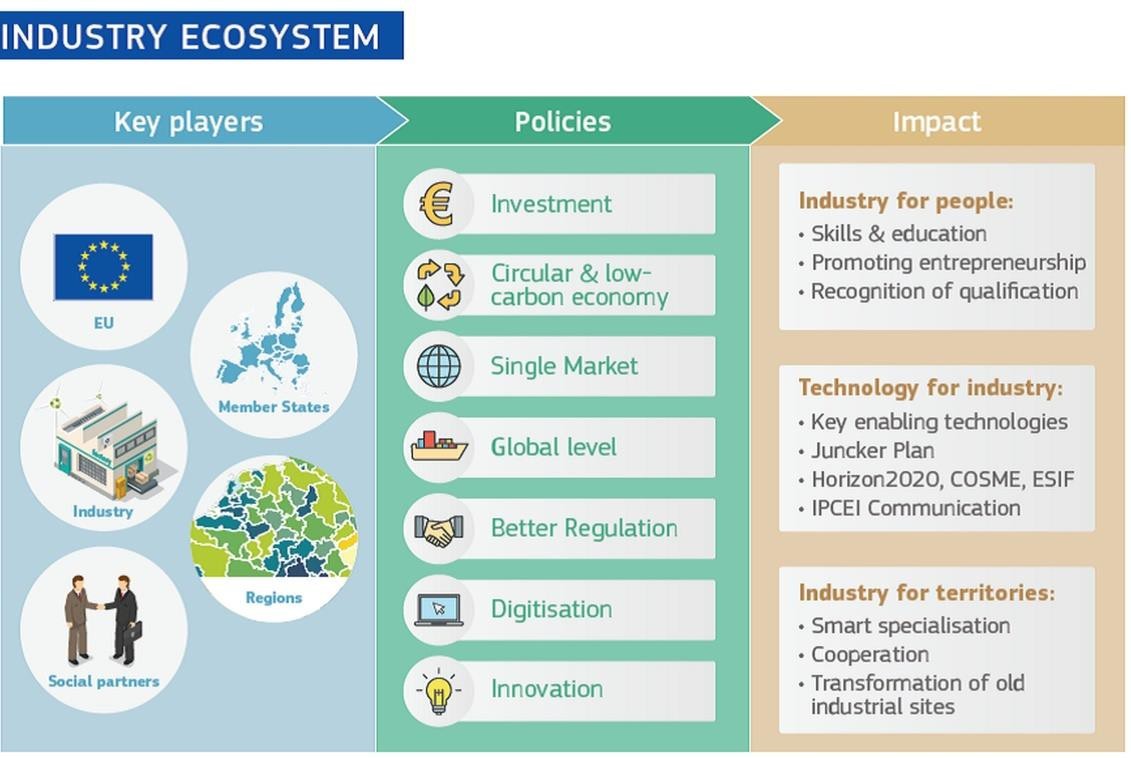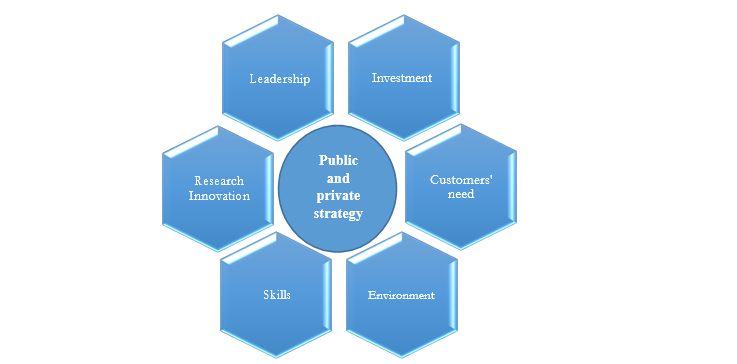The New EU Industrial Policy: A New Public Strategy or a New Business Strategy?

Abstract
The European Commission’s initiative on Digitising European Industry represents one of the most important measures launched in the latest years at the European level to both revive the economic growth in all EU member states and also to better support the competitiveness of the European economy on the global market. Also, this new initiative comes with a new approach in terms of strategic design, with many similarities with the strategic approaches from the private sector.
The objective of this paper is focused on this subject, specifically the new type of strategy adopted at the EU level and its possible implications on the future of public sector. Thus, we can see many similarities by comparatively analyzing the main characteristics of the strategic approach of a successful private company and the main characteristics of the strategic approach of the new EU policy. This approach can be considered the start of a new design of EU public policies.
The paper concludes that, taking into account, on one hand, the fact that the digitisation is a reality at global level, proving a high degree of dynamism that imposes rapid and constant adaptation by both private and public sector and, on the other hand, the context of globalization which may determine the public sector to change its type of strategies like the private sector, then a new type of efficient governance may be adopted.
JEL Classification: F680, L520, O380, L210
Table of contents
1. Introduction
2. Problem Statement: The digitisation and the agile governance
3. Aim of the research: From public strategy to business strategy
4. Research Method
5. Findings: Two strategies - one goal
6. Conclusions
1. Introduction
In the last few decades, humankind is both an observer and sometimes involuntary participant in the global transformation through the process of digitisation or as it became known the Fourth Industrial Revolution.
Talking about the impact on people, the World Economic Forum characterizes this process as being “a new chapter in human development”.
This new and challenging context forces somehow the leaders at the global level, both from private and public sector, to reconsider their development strategies in order to protect their place in the global ranking.
Taking into consideration these aspects, the European Commission started to rethink and redesign the EU strategies, especially since 2010, with the adoption of the ‘Europe 2020’ strategy (European Commission, 2010a).
The flagship initiative ‘An Industrial Policy for the Globalisation Era’ (European Commission, 2010b) focuses on the central objective of this policy, namely promoting the competitiveness of European industry.
2. Problem Statement: The digitisation and the agile governance
The evolution of digitisation is not just an easy way to increase the economic competitiveness and improve the governance, it is at the same time a phenomenon more complex and profound in many aspects.
For example, Klaus Schwab appreciates the changes that the Fourth Industrial Revolution brings as unprecedented “In its scale, scope, and complexity, the transformation will be unlike anything humankind has experienced before” (2015, p. 3).
Also, Andrew Ng, at the Stanford MSx Future Forum characterized artificial intelligence (AI) as “the New Electricity” (Li O., 2017).
Nowadays many think-thanks, NGOs, international institutions and experts in the field offer various and valuable analyses which, on the one hand, emphasize the huge benefits of digitisation and, on the other hand, expose and warn about the various implications.
Therefore, digitisation represents the biggest challenge of our times for managers, both in the private and in the public sector.
If the managers from private sectors were somehow familiarised with the challenges created by the competition on the free market, the managers from the public sector are new to this game.
For all managers, experts in the field offer various solutions, strategies, models and ideas of new management, leadership, innovation and creativity.
Isaksen and Tidd recommend the same solution for both the private and public sectors “Under these conditions, managers must learn how to become more flexible and agile in order to respond successfully” (Isaksen & Tidd, 2006, Preface). In their opinion “successful organizational transformation and managing change demand both leadership and management as well as creativity and innovation” (Isaksen & Tidd, 2006, Preface).
Taking into consideration the importance of innovation, Roland Bel in his work ‘Leadership and Innovation: Learning from the Best’ highlights the importance of having good leaders “And without great innovation leaders, there is no innovation” (Bel, 2010, p. 47).
For the public sector, the recommendation offered by Schwab to decision-makers is to embrace “… ‘agile’ governance, just as the private sector …”(Schwab, 2015, p. 9). It is worth noting the emergence of a new concept, namely the concept of ‘agile governance’, and Elmi and Davis (2018) have recently brought to the attention of those interested that “a global initiative on Agile Governance dedicated to reimagining policymaking for the Fourth Industrial Revolution” was launched by the World Economic Forum.
The concept of agile governance is defined as “adaptive, human-centred, inclusive and sustainable policymaking, which acknowledges that policy development is no longer limited to governments but rather is an increasingly multi-stakeholder effort” (Elmi & Davis, 2018).
Also Klaus Schwab warns policy makers about the risks involved in the process of digitisation “Ultimately, the ability of government systems and public authorities to adapt will determine their survival” (Schwab, 2015, p. 8).
Taking into consideration that, when we are talking about the ‘ability’ of government systems to adapt, we are mainly talking about conceiving adequate strategies, this paper intends to go further with the idea of the new governance or ‘agile governance’.
Thus, this paper analyzes the possibility that, in the future, the classic type of public strategies will look more like business strategies.
3. Aim of the research: From public strategy to business strategy
As can be seen, The Fourth Industrial Revolution brings, in essence, changes in everything.
At the EU level, the change was officially adopted with the 2020 Strategy, however the most daring change was accomplished with the adoption of the new EU strategy ‘A renewed EU Industrial Policy Strategy’ launched on September 2017 (European Commission, 2017).
The key aspect of that evolution, besides other changes like an holistic approach and servitisation, was the fact that both sectors, public and private, became officially interdependent.
The aim of the research is to identify similarities between the new EU industrial strategy and business strategies. This aspect is useful in creating a theory, that in the future, the concept of public strategy will suffer significant changes, meaning it will ‘borrow’ more characteristics from the business strategies and thus will revolutionize the concept of public governance itself.
4. Research Method
In order to track and better understand the evolution of the relationship between governance and economic development in the EU, first a proper definition of industrial policy is needed.
The most common form is that of Warwick who defines it as “any type of intervention or government policy that attempts to improve the business environment or to alter the structure of economic activity towards sectors, technologies or tasks that are expected to offer better prospects for economic growth or societal welfare than would occur in the absence of such intervention” (Warwick, 2013, p. 8; Pellegrin et al., 2015, p. 17).
Thus, according with this definition, through its history, the business sector was somehow influenced by the public sector.
But this ‘relation’ was not so mutually advantageous all the time, with reference to the phase of sectoral industrial policy or ‘French industrial policy’ characterized by interventionism.
That’s how the need for a closer cooperation between them appeared because “Setting up good policies is not enough if the private sector is not involved” (Pellegrin et al., 2015, p. 54).
The latest development of this collaboration is promoted in the new EU strategy ‘A renewed EU Industrial Policy Strategy’ where all stakeholders are involved in design and implementation of industrial policy. More than this, the strategy itself borrowed some characteristics of the business strategy.
In order to identify the similarities between the business and the public sectors, through a comparative method, a parallel view was created between the main characteristics of a business strategy and the main characteristics of the renewed EU industrial policy strategy.
5. Findings: Two strategies - one goal
A. Private sector – Saint-Gobain, a business strategy for the global challenges
Concerning the ability of private sector to survive the various challenges during times of hardship, there is no doubt.
The private sector has always found the right solutions not only to survive but also to be globally competitive.
Thus, innovation, research and professional development are very common terms in all successful business strategies.
As an example for a successful private strategy, in order to analyse its main characteristics, one can choose any global leader, but a relevant strategy for this analysis should focus on the manufacturing field, given the challenges of this sector.
Saint-Gobain is a French enterprise over 350 years old (1665-present), one of the world’s largest manufacturing companies, currently acting as a group, in several countries and sectors of activity.
As can be seen on its website, the activity of the Saint-Gobain Group began in October 1665 in Paris, when the king granted the donor Nicolas Dunoyer and his associates the exclusive right to produce “mirror glass” in order to compete directly with the supremacy of Venice on the European mirror market.
Today, the Group’s activity is represented in more than 67 countries, over 179,000 employees, 8 research centres, 3 activity hubs: innovative materials, construction products and building distribution.
The Group’s motto is “Saint-Gobain, a key ingredient in the wellbeing of everybody and thefuture of all”.
The main characteristics of the Saint-Gobain strategy can be summarized as follows:
- Vision oriented to development and performance: for example at high-performance materials is No. 1 worldwide, at flat glass is No. 1 in Europe and No. 2 worldwide, and so on;
- Positioning research, development, innovation as a focal point in its development strategy: since 2011 is included in the top 100 Global Innovators by Clarivate Analytics. In opinion of Pierre-André de Chalendar, Chairman and Chief Executive Officer “Innovation is at the heart of Saint-Gobain’s strategy. More than 23% of our sales are generated through products which were developed less than five years ago.” Also, Saint- Gobain sees “Researchers, a driving force”;
- Care for human capital: Saint-Gobain certified Top Employer 2018 in 31 countries by the Top Employers Institute;
- Saint-Gobain’s HR policies are structured around 4 priorities: professional mobility, team diversity, employee commitment and talent development;
- Strong relation with customers: “Listening to market needs”, “Stronger ties with Group marketing”;
- Environmental awareness: “Developing a culture of eco-innovation”.
B. Public sector – ‘A renewed EU industrial policy strategy’, a public strategy for the global challenges
In support of increasing the competitiveness of industry, in 2010, the European Commission launched the flagship initiative “An Industrial Policy for the Globalisation Era” as part of ‘Europe 2020’ strategy.
But at the European level, the Member States, which have identified an opportunity to increase faster and easier their competitiveness through adaptation and integration of digital technologies in the industry, developed many initiatives in this field, as Industry 4.0 in Germany, Industrie du Futur in France, Smart Industry in Netherland, and so on.
This ‘movement’ is called the New Industrial Revolution or the Fourth Industrial Revolution and is considered by industry experts to be the present stage of development of the industry, according to the classification for industrial technology development.
In this context, since April 2016, European Commission changed the approach of the industrial strategy and started an official process of digitisation of industry as “… a unique opportunity for attracting further investments into innovative and high growth digital and digitised industries in Europe” (European Commission, 2016a, p. 6).
This initiative was adopted after less than a year when a “strategy for a Digital Single Market proposed transformational actions for the European economy and society” (European Commission, 2016a, p. 15).
In May 2017, the European Council highlighting “the essential role of industry as a major driver for growth, employment and innovation in Europe and its contribution to the Union’s prosperity, as well as the critical importance of industry for dealing with major transformations in the EU economy, including sustainability, servitisation and digitization” and recognizing that “there is a need for a coordinated and strategic industrial policy framework at EU level” (European Council, 2017) called on the Commission to provide a holistic EU industrial policy strategy.
Therefore on September 13, 2017 the European Commission adopted the Communication ‘Investing in a smart, innovative and sustainable industry A renewed strategy for EU industrial policy’.
The new industry ecosystem is presented in Figure 1.

Source: http://europa.eu/rapid/press-release_IP-17-3185_en.htm
The main characteristics of the strategy can be found in its seven specific themes:
• a deeper and fairer single market: empowering people and businesses;
• upgrading industry for the digital age;
• building on Europe’s leadership in a low-carbon and circular economy;
• investing in the industry of the future;
• supporting industrial innovation on the ground;
• the international dimension, and
• partnership with Member States, regions, cities and the private sector.
The novelty of this strategy consists in the implementation method which “will require a joint commitment and systematic efforts on part of the industry as well as all relevant EU, national and regional stakeholders.” (European Commission, 2017, p. 6).
Another important and innovative aspect related to its implementation is the adoption of the collaborative dialog with all relevant stakeholders. Thus, two fora through this strategy were formalised: an annual European Industry Day and a High Level Industrial Roundtable.
In conclusion the common approaches of these two strategies can be observed below (Figure 2):

Source: Own interpretation
- maintaining the competitive edge, see the concept of “agile governance”,
- taking in consideration investment as a base for development,
- putting research and innovation as the focal point of the strategy,
- taking in consideration customers’ needs, see the concept of servitisation,
- considering as a vital aspect the skills of human capital, and
- taking in consideration the environment.
6. Conclusions
The digitisation is no doubt a reality and its speed of transforming the world is unprecedented.
The private sector learned how to manage the changes due to many challenges throughout the history. It learned how valuable it is to invest in human capital and how valuable it is to support innovation.
For example, the history of Saint-Gobain revealed to us how important innovation was in supporting its development.
Thus, it can be seen that on December 1688, the company obtained “the privilege of manufacturing large sheets of mirror glass using a revolutionary procedure”. In 1952 its first Research Centre was opened.
In the renewed strategy for EU industrial policy the influences from private sector can be evidently seen. More than this, in the implementation of this strategy an important contribution is expected to come from the private sector as it is also a beneficiary.
There are significant differences between the public and the private sector in both their goals and their methods and these differences will not fade away in the current economic paradigm.
However these sectors have grown closer together as far as management and strategies are involved.
From the point of view of this paper, a successful and sustainable public strategy needs to reconcile its main purpose of serving all its citizens with the dynamism and flexibility of the private sector, while maintaining a core competitive edge ready to adapt to the challenges of the future.
Contributo selezionato da Filodiritto tra quelli pubblicati nei Proceedings “International Conference on Economics and Social Sciences – Challanges and Trends in Economic and Social Sciences Research - 2018”
Per acquistare i Proceedings clicca qui:
http://www.filodirittoeditore.com/index.php?route=product/product&path=67&product_id=149
Contribution selected by Filodiritto among those published in the Proceedings “International Conference on Economics and Social Sciences – Challanges and Trends in Economic and Social Sciences Research - 2018”
To buy the Proceedings click here:
http://www.filodirittoeditore.com/index.php?route=product/product&path=67&product_id=149



